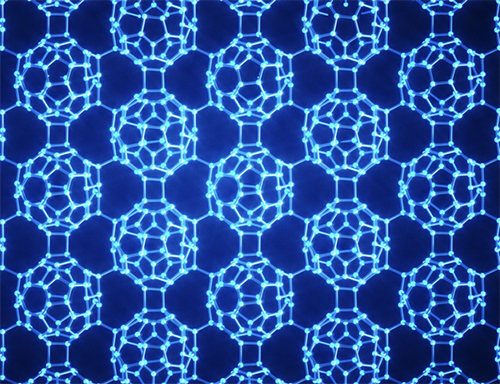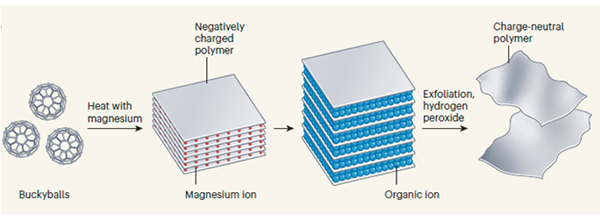Chinese scientists make progress in creating novel 2D single-crystal carbon material

Figure 1. Schematic of crystal structure of monolayer qHP C60
Supported by the National Natural Science Foundation of China (Grant No. 22175184, 22105207), Prof. Zheng Jian’s group from the Institute of Chemistry of the Chinese Academy of Sciences (ICCAS) has created a new type of carbon allotrope under atmospheric pressure, which is a monolayer single crystal of quasi hexagonal polymerized C60 (denoted as qHP C60) (Figure 1). These findings were published in Nature on June 15, 2022, entitled “Synthesis of a monolayer fullerene network”. The link to the article: https://www.nature.com/articles/s41586-022-04771-5. News & Views of Nature also published a related perspective highlighting the creative work entitled “Molecular soccer balls connected to make a 2D material”. Website link: https://www.nature.com/articles/d41586-022-01568-4.
Carbon is one of the most diverse elements in the periodic table. It can form chemical bonds in a variety of hybridization forms to obtain a unique π electron conjugation system, thus showing excellent mechanical, thermal, optical and electrical properties. These properties of carbon materials are closely related to their topological structures. Therefore, it is of great significance to create new carbon allotropes, especially those with band gaps. The preparation of a brand-new carbon material has been a frontier research topic in the field of materials science. The discovery of new carbon materials, such as fullerenes, carbon nanotubes, graphene and graphyne, has always triggered a research upsurge. However, due to the lack of effective and reliable synthesis methods, the discovery of new carbon materials remains a great challenge.

Figure 2. Synthetic route of monolayer qHP C60.
The research group led by Prof. Zheng Jian has developed a synthesis strategy (Figure 2) for new carbon materials. They successfully prepared a two-dimensional monolayer polymerized C60 single crystal and identified its crystal structure. By adjusting the ratio of magnesium to C60, two closely aligned magnesium intercalated polymer single crystals, quasi hexagonal and quasi tetragonal phase, were obtained at atmospheric pressure. An organic cation slicing strategy was then employed to exfoliate the intercalated quasi hexagonal C60 single crystals into monolayer with tetrabutylammonium salicylate as an exfoliation reagent. The results of single-crystal X-ray diffraction and scanning tunneling electron microscopy certify that adjacent C60 is connected by carbon-carbon bridged single bond and [2+2] cycloaddition bridged bond in one layer of qHP C60, forming a new two-dimensional topological structure. This research has added a new member to the family of carbon materials. The method of constructing a two-dimensional topological structure using zero-dimensional clusters provides a new perspective on exploring new carbon materials.
The monolayer qHP C60 has been shown to be a semiconductor with a band gap of about 1.6 eV, which makes it a potential candidate for use in electronic and optoelectronic devices. Due to the asymmetric structure, the monolayer qHP C60 has remarkable in-plane anisotropic property, and it’s expected to be applied in the fields of nonlinear optics and functional electronic devices. Moreover, the unique conjugated system, lattice and porous skeleton structure of this new carbon material indicate its potential applications in superconductivity, quantum computing, spin transport, energy storage and catalysis.
Contact Us

National Natural Science Foundation of China
Add: 83 Shuangqing Rd., Haidian District, Beijing, China
Postcode: 100085
Tel: 86-10-62327001
Fax: 86-10-62327004
E-mail: bic@nsfc.gov.cn
